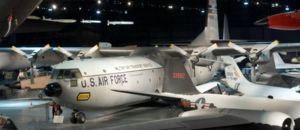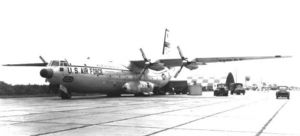PlaneSpottingWorld welcomes all new members! Please gives your ideas at the Terminal.
C-133 Cargomaster
The Douglas C-133 Cargomaster was a large cargo aircraft built by the Douglas Aircraft Company between 1956 and 1961; 50 aircraft (32 C-133A and 18 C-133B) were constructed and put into service with the USAF. A single C-133A and a C-133B were built and kept at Douglas Long Beach as "test articles." They had no construction numbers or USAF tail numbers.
The C-133 had large tail doors and side doors and a large, open cargo area. With the C-133B, the rear cargo doors were modified to open to the side (petal doors), making an opening large enough to transport ballistic missiles such as the Atlas, Titan and Minuteman more cheaply, safely and quickly than road transport. Several hundred Minuteman and other ICBMs were airlifted to and from their operational bases. The C-133 also transported Atlas, Saturn and Titan rockets to Cape Canaveral for use as launch boosters in the Gemini, Mercury and Apollo space programs. After the Apollo capsules splashed down, they were airlifted in C-133s from Norfolk Naval Station or Hickam AFB to Ellington AFB, Texas, or to California.
The C-133 was for many years the only airplane capable of hauling very large or very heavy cargo. Despite the C-124's capabilities, there was much cargo that it could not carry because of its configuration with a cargo deck 13 ft (4 m) off the ground and its lower, though substantial, engine power.
By 1971, shortly before the introduction of the Lockheed C-5 Galaxy, the Cargomaster was obsolete as well as being worn out, and all were withdrawn from service in 1971. The C-133 was originally a 10,000-hour airframe that had been life-extended to 19,000 hours. Severe vibration had caused critical stress corrosion of the airframes to the point that the airplane was beyond economical operation any longer. The Air Force managed the C-133 fleet to keep as many as possible in service until the C-5 finally entered squadron service.
Contents
Records
C-133s set a number of unofficial records, including records for military transport aircraft on trans-atlantic and trans-pacific routes. Among the longest were non-stop flights from Tachikawa AB, Japan to Travis AFB, CA (17:20 hours on 22 May 1959)and Hickam AFB, HI to Dover AFB, DE in about sixteen hours. The only FAI officially-sanctioned record was in December 1958, when C-133A 62008 lifted a payload of 117,900 pounds (53,480 kg) to an altitude of 10,000 feet (3,000 m).
Crashes
Of fifty airplanes built, nine were lost in crashes and one was destroyed in a ground fire. Despite numerous myths and legends, the primary causes of most of the in-flight losses were most likely related to the C-133's stall characteristics. One airplane (C-133A 62014), lost at Goose Bay, Labrador, on 7 November 1964, crashed on takeoff because of ice accumulation on the wings. Electrical problems led to the ditching of C-133B 90534 near Okinawa on 30 April 1967. The last crash, of C-133B 90530 on 6 February 1970, was caused by the sudden propagation of an old 11 in (280 mm) skin crack hidden under paint to a total length of 17 ft (5.2 m). Large sections of skin peeled off into the engines and the airplane came apart at 23,000 ft. Despite these sad events, many crew members served for years in the C-133, accumulating flying time of 5,000 hours or more in the type.
Surviving examples

One (C-133A 62008) is preserved at the National Museum of the United States Air Force at Wright-Patterson Air Force Base near Dayton, Ohio. The Air Mobility Command Museum at Dover AFB, Delaware, has C-133B 90536. C-133A 62009 is at the Octave Chanute Aerospace Museum in Rantoul, Illinois, and C-133B 90527 is in the collection of the Pima Air and Space Museum, Tucson, Arizona. Two C-133As have been in storage at Mojave Airport, California, since the 1970s. They are N201AR (ex-62001) and N136AR (ex-40136). They are owned by Cargomaster Corp, Ted Stevens International Airport, AK, which also owns and occasionally flies C-133A N199AB (ex-61999). That airplane was never certificated by the Federal Aviation Administration for civilian operation. Thus, it must fly as a government aircraft, mostly for the State of Alaska, where the last known flights were in the summer of 2004. The ANC based aircraft flew test flights and then a real flight, carrying firetrucks and heavy equipment to the bush, on April 18th, 2006. There was also an example (C-133B 90529) at the New England Air Museum. However, a tornado swept through the museum in 1979, badly damaging many airplanes in the outdoor display collection, including the C-133. The airplane was literally twisted in half by the tornado. Two other airplanes, C-133A 62011 and 61998 were flown to the FAA technical Center in Atlantic City, NJ. There, they were used in aircraft fire research. One remains there, while the other was scrapped in 2003.
Operators
Specifications (C-133B)
General characteristics [1]
- Crew: 6 (2 pilots, 2 engineers, 1 navigator, 1 loadmaster)
- Capacity:
- Cargo: 110,000 lb (50,000 kg)
- Troops: Designed as a logistics transport, the C-133 carried only small numbers of passengers, usually associated with the cargo.
- Length: 157 ft 6 in (48.0 m)
- Wingspan: 179 ft 8 in (54.8 m)
- Height: 48 ft 3 in (14.7 m)
- Cargo deck: 86' 10" (26.47 m)
- Wing area: 2,673.1 ft² (248.34 m²)
- Empty: 109,417 lb (49,631 kg)
- Loaded: 275,000 lb ( kg)
- Maximum takeoff: 275,000 lb (125,000 kg) (C-133A) 286,000 lb (130,000 kg) (C-133B)
- Powerplant: 4× Pratt & Whitney T34-P-9W turboprops, 7,500 shp (2.29 MW) each
Performance
- Maximum speed: 312 kt (359 mph) (578 km/h)
- Cruise speed: 280 kt (322 mph) (519 km/h)
- Range: 3,560 nm (4,097 mi) (6,590 km) with 52,000 lb payload
- Service ceiling: 32,300 ft (9,800 m)
- Rate of climb: ft/min ( m/min)
- Wing loading: lb/ft² ( kg/m²)
References
- ↑ The Aviation Zone (2005). "C-133 Cargomaster Specifications". Retrieved 28 August 2005.
- Remembering an Unsung Giant: The Douglas C-133 Cargomaster and Its People [1], Cal Taylor, Firstfleet Publishers, Olympia, WA, 2005. Available April 2006.
Naval Fighters: XFD · F3D · F4D · F5D · XF6D - Fighters: XP-48 · P-70 · F-6 · F-10
Naval Attack: DT · T2D · XT3D · BT · TBD · SBD · XBTD · XTB2D · AD · XA2D · A3D · A4D
Bomber: YB-7 · YB-11 · B-18 · XB-19 · XB-22 · B-23 · B-26 · XB-31 · XB-42 · XB-43 · B-66
Attack: XA-2 · A-20 · A-24 · A-26 · A-1 · A-3 · A-4
Reconnaissance: O-2 · OD · O2D · O-31 · O-35 · YO-44 · YOA-5 · PD · P2D · P3D
Transports: C-1 · C-21 · C-39 · C-47 · C-53 · C-54 · C-58 · UC-67 · C-74 · C-110 · C-118 · C-124 · C-133 · C-24
Naval Transports: RD · R2D · R3D · R4D · R5D · JD · R6D - Experimental: DWC · D-558-1 · D-558-2 · X-3
Lists relating to aviation | |
|---|---|
| General | Timeline of aviation · Aircraft · Aircraft manufacturers · Aircraft engines · Aircraft engine manufacturers · Airports · Airlines |
| Military | Air forces · Aircraft weapons · Missiles · Unmanned aerial vehicles (UAVs) · Experimental aircraft |
| Notable incidents and accidents | Military aviation · Airliners · General aviation · Famous aviation-related deaths |
| Records | Flight airspeed record · Flight distance record · Flight altitude record · Flight endurance record · Most produced aircraft |

